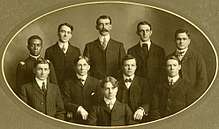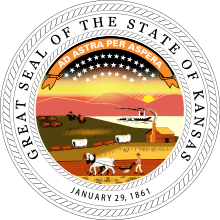Education in Kansas
| Education in the United States |
|---|
|
|
|
Education in Kansas is governed at the primary and secondary school level by the Kansas State Board of Education. The state's public colleges and universities are supervised by the Kansas Board of Regents.
Colleges and universities
The Kansas Board of Regents governs or supervises thirty-seven public institutions. It also authorizes numerous private and out-of-state institutions to operate in the state. In Fall 2009 the state's six public universities reported a combined enrollment of 93,307 students,[1] of which more than a quarter were non-resident students and more than a seventh were off-campus enrollments.
Among the state-funded universities, the University of Kansas (KU) is the largest in terms of enrollment, with 26,826 at its Lawrence campus, KU Edwards Campus in Overland Park, and Public Management Center (formerly the Capitol Complex) in Topeka. The total university enrollment, which includes KU Medical Center, was 30,004. About 31% were non-resident students.
Kansas State University (KSU) has the second largest enrollment, with 23,581 students at its Manhattan and Salina campuses and Veterinary Medical Center. About 19% were non-resident students. Wichita State University (WSU) ranks third largest with 14,823 students; about 14% were non-resident students. WSU has lost nearly 3,000 students since the school dropped football following the 1986 season. Fort Hays State University (FHSU), Pittsburg State University (PSU), and Emporia State University (ESU) are smaller public universities with total enrollments of 11,308, 7277, and 6314, respectively. FHSU has the fastest growing enrollment in Kansas with most of it coming from non-resident and off-campus enrollment. The composition of FHSU's enrollment includes 35% non-resident students and 44% off-campus enrollments. PSU also has almost a quarter of enrollment from non-residents.
For more on the universities and colleges in Kansas, see the complete list.
History

The first colleges in Kansas were chartered by acts of the Kansas Territorial legislature, signed by Territorial Governor James W. Denver, on February 9–12, 1858.[2][3][4] Among the ten institutes of higher learning chartered at that time, three survive in some form. Among those chartered on February 9 were Highland University (precursor to Highland Community College) and Blue Mont Central College (precursor to Kansas State University).[2] Baker University, chartered on February 12, 1858, has been operating continuously since that time and is now recognized as the oldest continuously-operating college in Kansas.[2]
All of the colleges founded in 1858 were private institutions. The first public institute of higher learning in the state was Kansas State University (originally named Kansas State Agricultural College), which was established by the state legislature on February 16, 1863.[5]
The state's universities were among the first public universities in the country to be coeducational. Kansas State became the second coeducational public institution of higher education when it opened in 1863; enrollment for the first session was 52 students: 26 men and 26 women. The University of Kansas was also among the earliest to offer mixed-sex education, in 1869.[6] Both KU and Kansas State were also open to students of all races from their inception.
Primary and secondary schools
Statewide elections for the Kansas Board of Education are held every four years.
Brown v. Board of Education of Topeka
The landmark 1954 decision in Brown v. Board of Education of Topeka, in which the United States Supreme Court ruled segregation in public schools unconstitutional, was brought as a legal challenge to a Kansas law permitting racial segregation in primary and secondary schools in Kansas towns with a population over 15,000.
In 1951, a class action suit was filed against the Board of Education of the City of Topeka, Kansas in the United States District Court for the District of Kansas. The plaintiffs were thirteen Topeka parents on behalf of their 20 children.[7]
The suit called for the school district to reverse its policy of racial segregation. The Topeka Board of Education operated separate elementary schools under an 1879 Kansas law, which permitted (but did not require) districts to maintain separate elementary school facilities for black and white students in 12 communities with populations over 15,000. The plaintiffs had been recruited by the leadership of the Topeka NAACP. Notable among the Topeka NAACP leaders were the chairman McKinley Burnett; Charles Scott, one of three serving as legal counsel for the chapter; and Lucinda Todd.
The named plaintiff, Oliver L. Brown, was a parent, a welder in the shops of the Santa Fe Railroad, an assistant pastor at his local church, and an African American.[8] He was convinced to join the lawsuit by Scott, a childhood friend. Brown's daughter Linda, a third grader, had to walk six blocks to her school bus stop to ride to Monroe Elementary, her segregated black school one mile (1.6 km) away, while Sumner Elementary, a white school, was seven blocks from her house.[9][10]
Evolution controversy
In 1999, the Kansas Board of Education ruled that instruction at the primary and secondary levels about evolution, the age of the earth, and the origin of the universe was permitted, but not mandatory, and that those topics would not appear on state standardized tests. However, two years later, following a change in its elected membership, the Board reversed this decision on February 14, 2001, ruling that instruction of all those topics was mandatory and that they would appear on standardized tests.
Following another change in membership, on August 9, 2005, the Board of Education approved a draft of science curriculum standards that mandated equal time for evolution and intelligent design.
On November 8, 2005 the Board of Education voted 6–4 to allow science students in public schools to hear materials critical of evolution in biology classes, allowing teaching of Intelligent design to be taught in classes. The board, in order to accommodate the teaching of Intelligent Design in biology class, went so far as to redefine the meaning of science to 'no longer limited to the search for natural explanations of phenomena.'
In response, USD 383 (Manhattan-Ogden) decided to reject the November 2005 standards in a unanimous decision on February 2006, and continues to use the March 9, 2005 standards.
On August 1, 2006, the creationist majority on the Board of Education was voted out of office and evolution candidates were given the majority once again.[11]
On February 13, 2007, the Board voted 6 to 4 to reject the amended science standards enacted in 2005. The definition of science was once again limited to "the search for natural explanations for what is observed in the universe." [12]
See also
References
- Kansas Board of Regents. ""Enrollment Headcount at Kansas State Universities—Fall 2004"" (PDF). Archived from the original (PDF) on November 11, 2006. (50.6 KiB).
- ↑ "Regents Announce 2009 Enrollment" (English). Retrieved 2010-02-15.
- 1 2 3 Kansas, (1858). Private Laws of the Territory of Kansas, 1858. pp. 71–91.
- ↑ Willard, Julius (May 1945). "Bluemont Central College, The Forerunner of Kansas State College". Kansas Historical Quarterly. Retrieved 2009-06-02.
- ↑ Jacobson, A. Ryan (May 21, 2006). "Kansas' Oldest College Looks to Future". The Topeka Capitol-Journal. Retrieved 2009-06-02.
- ↑ Willard, Julius (1940). History of Kansas State College of Agriculture and Applied Science. Kansas State College Press.
- ↑ "Kansas: A Cyclopedia of State History". Archived from the original on May 4, 2011. (co-ed secondary-level classes began in 1866)
- ↑ Anderson, Legacy of Brown: Many people part of local case, Thirteen parents representing 20 children signed up as Topeka plaintiffs Archived August 28, 2008, at the Wayback Machine., The Topeka Capital-Journal (Sunday, May 9, 2004).
- ↑ Black, White, and Brown, PBS NewsHour (May 12, 2004).
- ↑ Brown v. Board of Education of Topeka MSN Encarta, archived on October 31, 2009 from the original Archived October 31, 2009, at WebCite
- ↑ "Interactive map of locations in Topeka important to the Brown case – Topeka Capital Journal online". Cjonline.com. October 26, 1992. Archived from the original on June 15, 2010. Retrieved October 15, 2010.
- ↑ "Evolution Opponents Lose Control of Kansas Schools". Fox News. August 2, 2006.
- ↑
